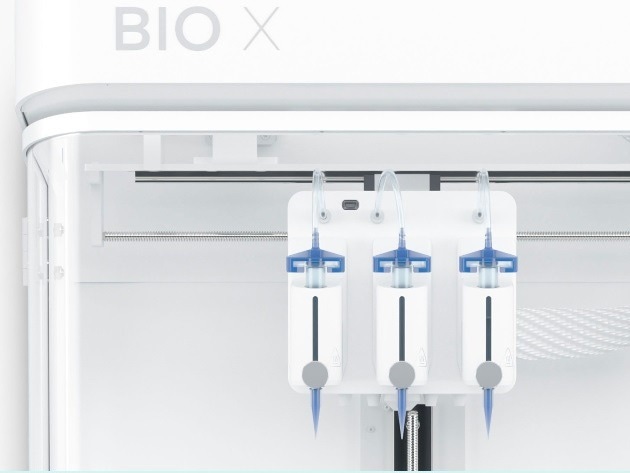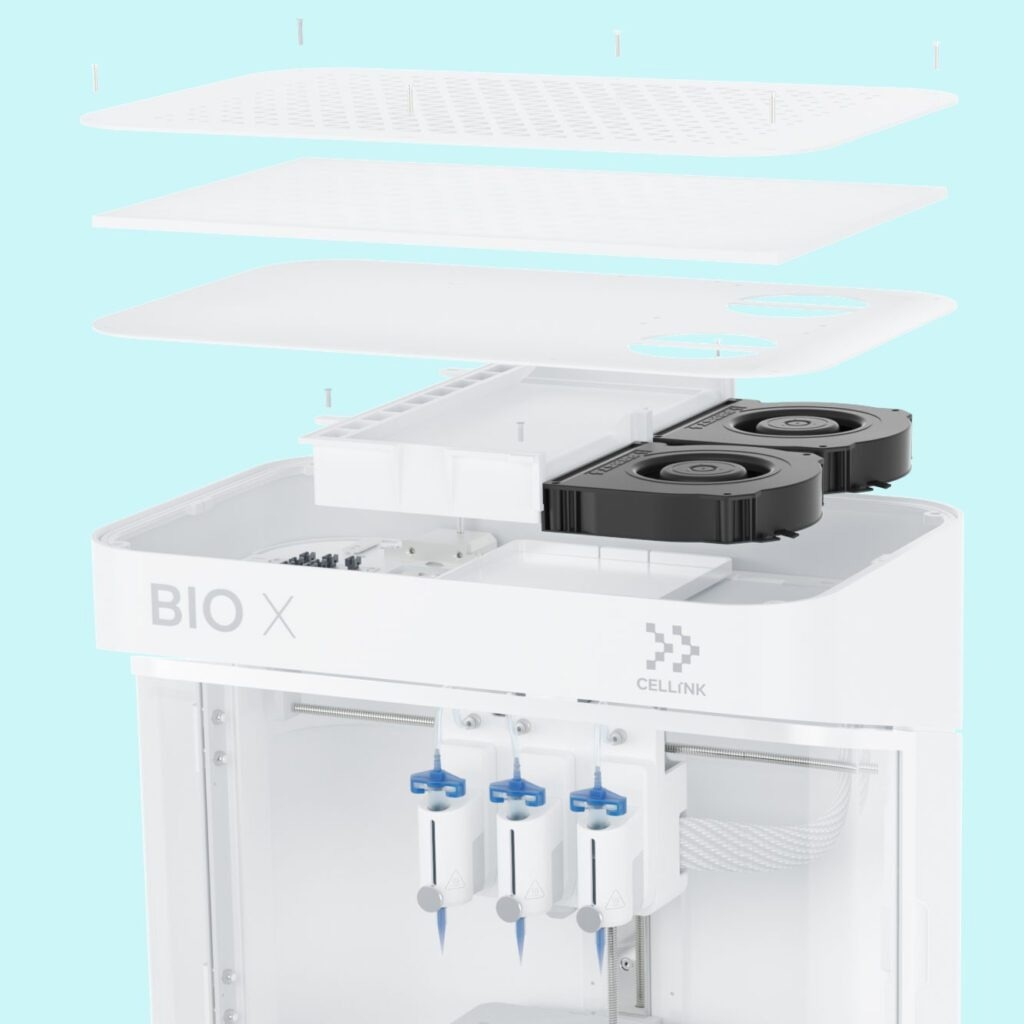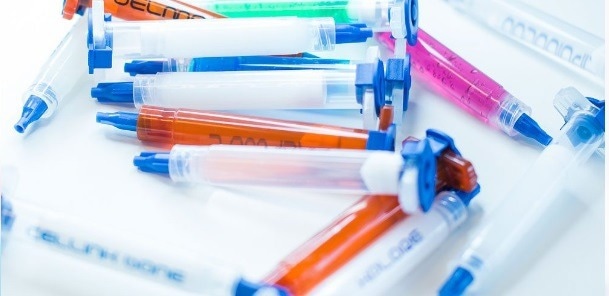Overview
For cell biologists, tissue engineers, and biomedical researchers, the generation 3 of the preferred 3D bioprinter is called BIO X™.
Key features
Open biomaterial platform
- The BIO X is made compatible with the broadest range of biomaterials that are currently available, despite the fact that a large portfolio of biomaterials is offered.
Better cell safety
- The BIO X transfers the sterility of the biosafety cabinet to the benchtop with the help of integrated HEPA filtration, UV sterilization, and the patented Clean Chamber™ technology.
Intelligent printheads for flexibility
- Users of the BIO X benefit from the maximum interchangeability and flexibility with the choice of intelligent printheads. The printheads were created to work with a variety of biofabrication projects.
DNA Studio 4 compatible
DNA Studio 4
Video Credit: CELLINK
- The generation 3 of the BIO X’s makes use of the most sophisticated bioprinting software currently on the market.
Advanced functionality and versatility

Image Credit: CELLINK
Simplify user workflows across a variety of application domains
- The BIO X is the bioprinter of choice for business leaders at the forefront of today’s biggest scientific discoveries due to its compatibility with practically any material.
- The BIO X 3D bioprinter has the cutting-edge functionality and adaptability to streamline workflows in a variety of application areas, whether the user is automating 3D cell cultures, creating complex tissue constructs, or testing new drug compounds.
Patented Clean Chamber for better cell safety
- A HEPA filter and integrated UV sterilization bring the biosafety cabinet’s sterility to the benchtop.

Image Credit: CELLINK
- As part of the Clean Chamber™ technology, which also includes UV-C germicidal lights, rounded edges, and positive air pressure, dual high-powered fans channel air through a HEPA H14 filter to remove 99.995% of undesirable particles and microorganisms.
- To guarantee complete sterility around the print area for the duration of the print, start the Clean Chamber before starting the experiment.
Universal biomaterial compatibility
- Open material platform, bioprint with the widest range of materials
- Although a wide variety of bioinks are available, CELLINK built the BIO X to be an open system that is compatible with the broadest range of materials on the market because they recognize the value of material development.
- Use the high-quality bioink development products to start creating one’s own bioinks, or look into the bioinks that are already ready for printing.

Image Credit: CELLINK
Excellent temperature control
- Accurate printhead and printbed temperature control allows for the bioprinting of a wider variety of materials and cell types.
- Enjoy precise temperature control when working with materials like collagen and gelatin that are temperature-sensitive, with a printhead temperature range of 4 °C to 250 °C and a printbed temperature range of 4 °C to 65 °C. The options are endless when users have access to a variety of different materials and cell types.
Grow the research with multiple, interchangeable, Intelligent Printheads
- BIO X is the first 3D bioprinter with Intelligent Printheads (iPH) in the world, putting user research first at all times.

Image Credit: CELLINK
- The possibilities are endless with an ever-expanding selection of intelligent printheads, giving users more freedom to advance their research. CELLINK’s family of sophisticated printheads is constantly expanding. Each printhead system is designed to work with a specific biofabrication application, ensuring the best outcome for any 3D bioprint.
Applications
The extraordinary features of the BIO X maximize adaptability to increase user’s success in the following application areas and beyond.
3D cell culture
Three-dimensional cell cultures provide several advantages over 2D cell cultures, which include the accurate geometrical organization of multicellular constructs that could recapitulate the native 3D human physiology in a better way. Extrusion-based bioprinters like the BIO X provides good flexibility while designing 3D cell culture systems, as they facilitate scientists to accurately manage geometries and the spatial patterning of cells and other biomaterials.
Tissue models and engineering
The BIO X enables 3D bioprinting with a maximum of three printheads, thereby allowing multi-material and multi-cell flexibility in large and small tissue engineering. The world is the oyster of users.
Organ-on-a-chip
Future drug trials may forego many preclinical steps as a result of the combination of bioprinting and microfluidics, which paves the way for personalized, on-demand organ-on-a-chip models.
Multi-printhead technology can be used in a one-step fabrication design with spatial heterogeneity of tissues, and the BIO X in combination with microfluidic systems like the VasKit perfusion system allows for complex organ-chip models.
Drug delivery
In addition to printing with cells, bioprinters can also be used to create extended-release technologies and hydrogel drug encapsulation. Different printheads are available for the BIO X bioprinter’s compatibility with various hydrogels. The hydrogels can be used to combine drugs and bioactives, and patterns like large patches or tiny beads can be printed on them.
Soft robotics
Emerging technology combines material science, biomechanics, sensing, and cells to create biohybrid soft robotics. Making use of 3D bioprinting allows for the fabrication of systems with precise geometries and spatial cell type patterning.
To enable more varied controls and functions, such systems can be further integrated or bioprinted with cutting-edge nanomaterials and biosensors.
Technical specifications
Source: CELLINK
| . |
. |
| Outer dimensions (L*W*H), mm |
477x441x365 |
| Weight, kg |
18 |
| Build Volume, mm |
130 x 90 x 70 mm |
| Build surface compatibility |
Multi-well plates, petridishes, glass slides |
| Resolution XY, μm |
1 |
| Layer Resolution, μm |
1 |
| Pressure range (internal pump), kPa |
0-200 |
| Pressure range (external air supply), kPa |
0-700 |
| No. of printhead slots |
3 |
| Photocuring sources (built-in), nm |
365, 405, 485, 520 |
| Printbed temperature range, °C |
4-65 |
| Printhead temperature range, °C |
4-250 (printhead specific) |
| Filter class, chamber air-flow |
HEPA 14 |
| UV-sterilization |
UV-C (275nm), 20mW output |
| Calibration Options |
Manual and Automatic |
| User Interface |
Integrated Display, DNA Studio |
| DNA Studio OS compatibility |
Windows |
| Connectivity |
USB Storage, Ethernet connection |
| Supported file formats, software |
.gcode, .stl |